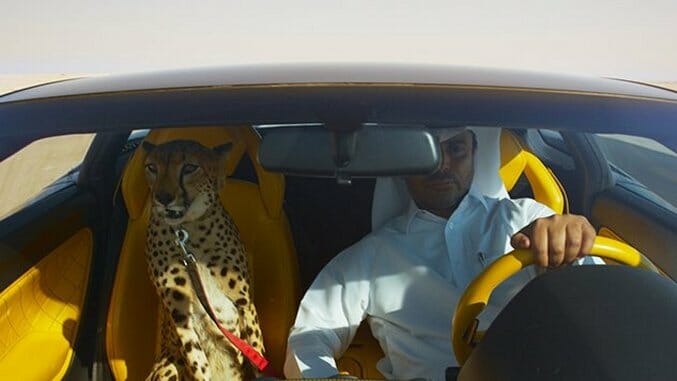The Challenge
Photo: Slingshot Films
The Challenge lives up to its title in more ways than one. Literally, Yuri Ancarani’s documentary is about a falcon tournament held in a desert in Qatar, in which Qatari sheikhs gather to participate in hunting competitions and bird auctions. But on an aesthetic level, Ancarani issues a challenge of his own: The Challenge eschews a standard informational talking-heads style in favor of a fly-on-the-wall approach, at times recalling Frederick Wiseman in his deliberate forsaking of context. Only, Ancarani’s film feels nothing like those of Wiseman. Instead, with its impeccably framed wide compositions, immersive long takes, and a cross-cutting narrative style that touches on the work of Matthew Barney—or, in a considerably more mainstream vein, Christopher Nolan—The Challenge feels like avant-garde art more than anything else.
Ancarani, an Italian filmmaker and video artist, may be an unapologetic aesthete in his gaze, but in The Challenge he rarely allows visual beauty to overwhelm genuine anthropological fascination. Though the film isn’t exactly chock full of dialogue, the bits of conversation we do see and hear demonstrate, among other things, the reverence with which these upper-crust Arabs regard falcons and falconry. “God willed it” is a phrase many of them frequently utter when beholding these beloved birds’ actions. Though Ancarani never goes so far as to interrogate an interview subject in order to probe the historical and cultural origins of this adoration for falcons, such brief moments are nevertheless, in the context of a film that remains steadfastly committed to a “less is more” aesthetic, enough to broaden the film’s scope.
Tradition versus modernity provides the film’s other major unspoken thematic thread. Ancarani subtly plays up the disconnect between seeing modern-day SUVs and motorcycles traversing these desert landscapes, holding on such shots long enough for us to consider the contrast between old and new, natural and technological. These images are bound to trigger deeper associations: in particular, the idea of these sheikhs holding onto some of their older belief systems even as they embrace modernization. Perhaps this explains Ancarani’s inclusion of a thread revolving around a gang of bikers who, at one point, stop in the middle of their ride through the desert and set down a rug in order to collectively pray to Mecca. Though this thread appears tangential to the main narrative, it nevertheless gains significance as a back-up example of the way even lower-class Arabs hold onto traditions of the past while welcoming a more contemporary lifestyle.